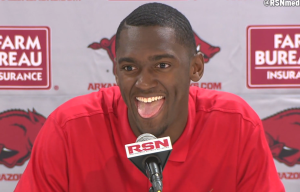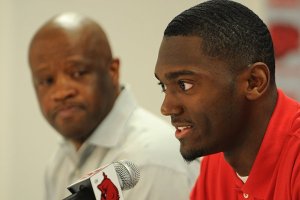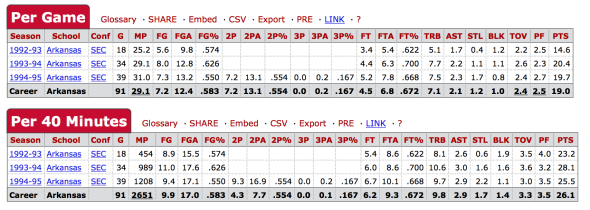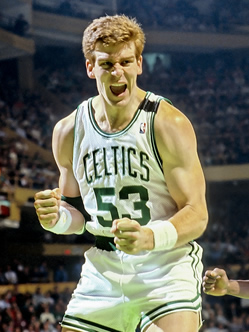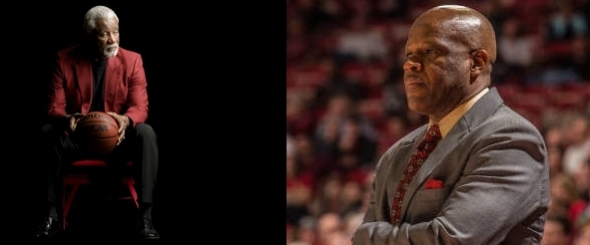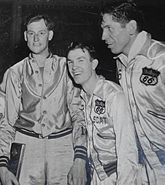Bobby Portis Channels Trey Songz In Farewell Press Conference
Posted: April 15, 2015 Filed under: Pro basketball, Razorback basketball | Tags: Bobby Portis, Hall High School, Mike Anderson, Trey Songz, trey thompson 1 CommentBobby Portis doesn’t have much hair.
But what little he has, he let down in full during a Tuesday press conference after announcing he was taking his game to the next level. In basketball, he’s a potential lottery pick. In singing, he’d be lucky to find volunteer work in Bulgaria. Below is the full conference transcript. Excerpted video of Portis’ serenade is near the middle.
Mike Anderson: This is a day that, you know, you have dreams when you’re a young kid. Coming here, taking this job four years ago, one of the first tasks that I had was to go down to Hall High School, and see this young man work out. In that spring, in that summer, this committed to the University of Arkansas. His sophomore, you’re talking about finishing his sophomore year, so when you talk about a guy committed early, this guy committed early, so to sit here four years after that, and he has an opportunity to realize his dream. It’s kind of a more sweet than it is bitter day. Why, because this kid, he’s part of my family, and that’s Bobby Portis, as well as all my other players on our team. When you talk about a young man who’s had two unbelievable years, it’s amazing what has taken place. In his freshman year, he’s second team All SEC. His second year. You got to understand this. He’s second team All-American. That is a special, special year, and that’s why we are here today.
His teammates are here in attendance, as well as our staff, as Bobby has announced that he will be moving beyond that, and I’ll let him talk more into that. As a coach, he’s been a great ambassador for our university. He’s a great basketball player, we know that, but he’s been a great, great ambassador, a great, great role model for a lot of young players around, young people in the state of Arkansas and around the country. We could not have a better representative than Bobby Portis. To be here today as he makes his statement, I couldn’t be no more proud of Bobby Portis. Player of the year in our league. Things that haven’t taken place here in 20 years. That tells you how special he is. Not only special Bobby is, but his teammates as well. He’ll be the first to say that. I can’t talk any more, because I get a little emotion, but to Ms. Tina, I want to thank her for entrusting me with her son. I told her, “You send me a young boy, I send you back a man.” Well, he kind of expedited the process. I told him to go at his own pace, as a freshman, because coming in, you can imagine, McDonald’s All-American, all the pressures, and I said go at your own pace. His pace was a tremendous pace, and that’s why we’re here today. I just pass over here to Bobby Portis.
Bobby Portis: How everybody doing today? Ain’t nobody sad or nothing, is it? Everybody good? You know, today’s a good day
for me, to try to take that next step and go to the NBA. As a kid, all kids grow up wanting to go to the NBA. For me, myself, I finally had that first chance to go to the NBA this year, so I took the opportunity and tried to run with it. Thanks for Coach A for always having that trust in me, on and off the court. He made me a captain this year, as a sophomore, and I think that’s big for me and my teammates. Thanks for my teammates, always having their trust in me, on the court, passing the ball to me, even though I’m hollering, “Give me the ball! Give me the ball!” All that stuff. Thanks to Coach [Matt Zimmerman] staying late in the gym with me, and always rebounding for me and all that. Thanks to the managers, too, and Coach Watkins and Coach Cleveland. You’re all a part of my family, now, and this is something that I’m proud of, so thank you all and God Bless.
Reporter: You really talked a lot about your mom and what she means to you. How big a part was her, how hard she works and what she does, in your decision?
Bobby Portis: It was a big part, just because, my mom, she works 2:00 AM to 1:00 PM. That’s an 11 hour shift. For any person, that’s a tough burden on anyone, so I just want to take that next step, not just for her, but for myself. I’m not doing this for my mom, or anything, I’m doing this for Bobby Portis, just because I feel like I’m ready to take that next step, and go on about my basketball career.
Reporter: In the beginning you said it was going to be a committee decision. In the end, was it just you that made the call?
Bobby Portis: I believe so, just because, my mom wanted me to make the decision for me and not her. That’s something that she always preaches. Not trying to make me make a decision for her, just to change her life and my little brother’s life. She wants me to live my dream and try to be the best basketball player I could be.
Q: I understand it’s a basketball on one side, but how nice is it that you’re going to be able to help your family out?
Bobby Portis: I think it’ll be nice to help my family out, but I still have to work as hard as I can every day, and just try to be that same person that I was, and just stay humble and hungry. Just because, if I get my name called and put that hat on, that doesn’t mean that it’s just the end of the road and I get money. It’s more than just money. It’s a job, too, at the same time.
Q: What kind of feedback did you get from the NBA folks about where Bobby’s likely to be drafted?
Mike Anderson: First of all, this wasn’t an easy decision for Bobby. This guy, again, he committed as a sophomore to be a Razorback, and trust me, he’s been wrestling with this. I know you guys, whether it be social network, or we continued at the banquet last night, “Hey, Bobby, what you going to do?” It wasn’t an easy decision for him, so we gathered information for him, in terms, of where, what’s going to take place. Obviously, from the lottery to first round. He’s going to be … He’ll be a first rounder, there’s no question about it. Where? That remains to be seen. I have all the confidence in this guy, right here. He’s on the fast track, on the fast track to do some great things. No one can knock his work ethic. For a 6’11” guy, that can do the things that this guy does, is remarkable. He has that burning desire, to not only be a good player, so even as he goes to that next level, he don’t just want to be a good player in the NBA, he wants to be a great player in the NBA. I don’t question anything this guy puts his mind to. The feedback we got was very positive, and so we sat down, and just discussed it. At the end of the day, it was Bobby’s decision, and I think, one thing about it is that, I think, for him, I think he made the right decision.
He’s done some great things here for us, here at the University. Took us some places we hadn’t been in a while. I think he just starting something that’s really going to continue to take place, and when you talk about elite players, having the opportunity to come in, and have a chance to showcase the God gifted talents. He took my word, when I sat there with he and his mom, because there’s a lot of places he could have went. There’s a lot of programs he could have went. He chose the University of Arkansas. In the matter of a year, two years, now he’s had an opportunity to go and live his dream. It’s a big statement in a lot of ways. I’m sure the basketball people out there, the NBA teams, and hopefully, the recruits understand that, you know what – we get it done here at the University of Arkansas. Our kids, they develop. They do it the right way on and off the floor and when they leave here they will be ready, not only for the NBA, but they will be ready for the real world.
Q: What was the tipping point when you decided everything?
Bobby: Last Tuesday me and Coach Anderson sat down and talked about everything. He just laid out two or three scenarios and from there, I kind of ran with it. I sat down and told him then that I thought I was ready to make that next step. I made it last Tuesday.
Q: … How tough a decision was it? … Like Mike said, it was something you had to wrestle with.
Bobby: Man, last night I played this song, “I don’t want to leave, but I got to go right now.” That was cold, though. No, it was a tough decision for me just because growing up in the state of Arkansas and being a native of this state, I felt like I was a great ambassador for our basketball team and for our program, not only for the basketball team, but for the whole, entire Razorbacks. I believe I showed kids that you don’t have to go to Kentucky or Florida just to try to live your dreams. Coach Anderson and his staff gets it done here, too.
Joe Kleine Breaks Down Bobby Portis’ Post Game, Discusses North Carolina
Posted: March 20, 2015 Filed under: College basketball (non Hogs), Razorback basketball | Tags: Arkansas and North Carolina, Bobby Portis, Joe Kleine, Portis in the NBA, UALR 1 CommentI had the chance to talk to the Razorback legend for a North Carolina-Arkansas mini oral history which runs on Sporting Life Arkansas today. Kleine, who recently finished his eighth season as an assistant coach with UALR, was pivotal figure in leading Arkansas to an historic 1984 win over No. 1 UNC. I couldn’t help also ask him about what will happen in Saturday night’s second round game between the programs, in which Arkansas has a shot to break into its first Sweet 16 since 1996.
Q: What’s your take on the Tar Heels?
A: I think they’re talented. Especially Marcus Paige – he’s a really good point guard. Any time you’re pressuring as much as Arkansas does, a really good point guard worries you. Because he gets through there, he can cause a lot of trouble.”
Q: Bobby Portis has had a great season, you agree. In order for him to take his game to the next, where do you think he must most improve?
A: I’m a little leery to critique him because I’m not there, seeing him every day. These are things I’ve noticed just one or two times – in his post play, as with all young post players, he’s got to develop a counter move with his left hand.
I’ve seen him do some things with his off hand but he’s got to get the point where he can put it up over his shoulder with  his left hand as well as he does on the other side. Still, I love his face up game and his rebounding. He has a tenacity there that is a really, really good sign … He just has to continue to work on his face up game, get to the point where he can drive as well with his left hand as with his right.
his left hand as well as he does on the other side. Still, I love his face up game and his rebounding. He has a tenacity there that is a really, really good sign … He just has to continue to work on his face up game, get to the point where he can drive as well with his left hand as with his right.
Q: Sounds like he would do well to spend a little time in Hakeem Olajuwon’s post-up training academy.
A: I’m 53 years old, and I would be well served by spending time in that academy. That man is simply amazing.
Q: How good can Bobby be?
A: Worst case scenario, for Bobby Portis, I see Joe Kleine – a guy who can play a long time in the league, can spot shoot, can defend. Whether he can be a big time scorer, that remains to be seen. His ability to score against bigger, taller, more athletic guys is going to be indicative of what kind of career he’s going to have.
Q: Overall, who do you expect to win on Saturday night?
A: You could make an argument either way. You’ll have two good teams playing on edge, that have a lot to lose, with a lot of emotion. It’ll bring out the best in both of them … I’m a fan of Arkansas – that’s gonna push me toward them. I wouldn’t want to make a living having to pick the outcome of that game.
Q: UALR head coach Steve Shields was just let go. It’s hard for me not to ask: What are your plans now?
A: I want the job. I’ve thrown my name in, I’ll put that way.
Mike Anderson On One of the Strangest Box Scores in SEC History
Posted: February 26, 2015 Filed under: Razorback basketball | Tags: Alandise Harris, Arkansas Razorbacks basketball, Bobby Portis, Crazy block shot nights, Matt Zimmerman, Mike Anderson, Moses Kingsley, Oliver Miller, Strange rebound performances 1 Comment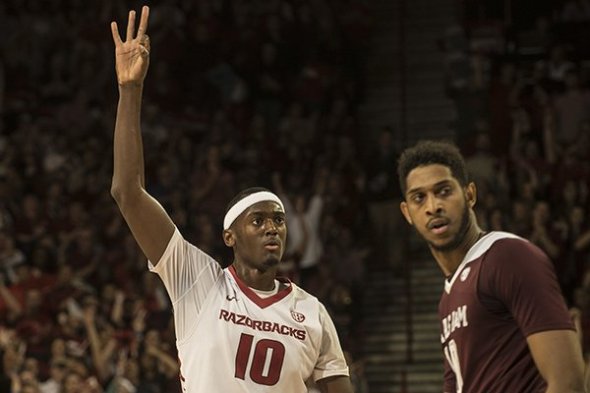
Portis’ three blocks contributed to a stat line funkification you won’t believe. (courtesy Arkansas Democrat-Gazette, Inc.)
Arkansas assistant coach Matt Zimmerman couldn’t believe it.
As ushers swept the seats of a cavernous Bud Walton Arena behind him, he sat courtside, looking down at the box score of a game that had just finished. It wasn’t the 81-75 final score that surprised him. These days, it seems, his No. 18 Hogs go into every game legitimately expecting to win. No, it was the way in which Arkansas had sewn up its seventh straight win.
On this bitter cold night, Texas A & M had outrebounded Arkansas 44 to 23. In the Razorbacks’ 40 Minutes of Hell style, getting out rebounded happens. Usually not by this much, but it happens.
The weird part?
While giving up so many boards – a stat stronger, bigger and more athletic teams usually win – Arkansas somehow also held a 12 to 0 advantage in block shots. Which is, of course, a stat that also usually goes to the taller, more athletic team. In this game, Alandise Harris likely had the defensive game of his year, chipping in four blocked shots, while Moses Kingsley and Bobby Portis added three swats each. Yet the fact that not a single Aggie touched an Arkansas shot attempt is a testament to the Hogs’ discipline and shot selection on offense.
Matt Zimmerman couldn’t recall such an unlikely disparity in his decades of coaching. Same goes for his boss Mike Anderson. “I’ve had some teams that have gotten out-rebounded by about 20, yeah, and [still] win the game” the head coach said. “On a of lot of those rebounds [the Aggies] would shoot it and go back and get it, shoot it and go back and get it. But we’ve got to correct that. To have 12 blocked shots and for them to have zero, that tells me our guys were pretty accurate. And in the first half we were blocking those shots and we were coming up with them, we were heading down the other end on the fast break. So, to do that against a team like Texas A&M – that tells me we are getting better.”
So, has anything like this ever happened before?
It’s very rare. I have confirmed Arkansas has pulled off the only -20 or more rebound/+10 or more block disparity in a Division I game this season. But, thanks to a tip from HogStats.com, it appears one Razorback team did something similar on December 11, 1990. In that game, a 10-point Arkansas win, Hogs center Oliver Miller went off for nine blocks and the team tallied 15 in all, according to separate records found by the HogStats editor.
Yet perhaps Miller was too hungry for a record-setting block night to corral many defensive rebounds, because South Alabama out-rebounded Arkansas 60-34 (Miller finished with seven total rebounds). We don’t know how many blocks South Alabama got this game (team blocks aren’t recorded in that season’s media guide), but it’s likely the number was less than five. If anybody can find record of that stat, please let me know.
N.B. Anderson would have actually coached in this game, as an assistant under Nolan Richardson, but I won’t hold it against him for not being to recall this one specific time in the .60 seconds he had to respond to me.
Dear readers, do you recall any other crazily anomalous statistical disparity games in college basketball history?
Mike Anderson Vs. Nolan Richardson: Comparing Their First 4 Years At Arkansas
Posted: December 4, 2014 Filed under: Razorback basketball | Tags: 40 Minutes of Hell, Anton Beard, Arkansas Razorbacks, Arkansas Razorbacks basketball, Bobby Portis, Iowa State vs Arkansas, Mike Anderson, Nolan Richardson Leave a commentFor Razorback fans, the question never gets old: Will basketball coach Mike Anderson lift the program to the same levels reached by his mentor Nolan Richardson? Tonight’s game, on the road against No. 20 Iowa State, should provide the best start of an answer yet. The greatest Arkansas teams of the early to mid 1990s regularly defeated ranked non-conference teams away from home but that hasn’t happened since 1997*. But, so far, all signs point to this being the best Arkansas team since that era.
The most dramatic evidence is below. Look at this steady improvement through Anderson’s first four seasons in Fayetteville:
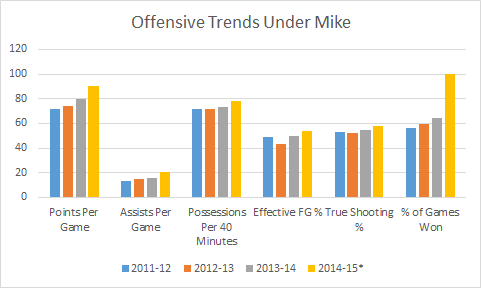 The Razorbacks’ scalding shooting from the outside this season – 46% on three-pointers – has been a major reason for the boost in Effective FG % and True Shooting % (definitions below). That shooting helps space the floor and lead to a nation-leading assist rate. But the Razorbacks can’t rely on shooting at this clip in the kind of hostile environment the Cyclones’ Hilton Coliseum will present. So it’s important they get to the line and build an early lead.
The Razorbacks’ scalding shooting from the outside this season – 46% on three-pointers – has been a major reason for the boost in Effective FG % and True Shooting % (definitions below). That shooting helps space the floor and lead to a nation-leading assist rate. But the Razorbacks can’t rely on shooting at this clip in the kind of hostile environment the Cyclones’ Hilton Coliseum will present. So it’s important they get to the line and build an early lead.
Referee bias (conscious or not) toward the home college team makes it doubly difficult for visitors to play from behind or in a back-and-forth affair. “On the road especially you want to help keep the officiating out of it as much as you can,” Nolan Richardson said in a phone interview.
As always, defense fuels offense for a “40 Minutes of Hell”-style program. The below numbers show that while Arkansas is playing at a faster rate than ever in the Anderson era (78 possessions per 40 minutes vs. 72 in his first year), they are barely giving up more points. This is a credit to the lower rate at which they are fouling this year than the past two seasons (more experienced players) and fresher second-half legs generating turnovers at a higher clip (more depth).
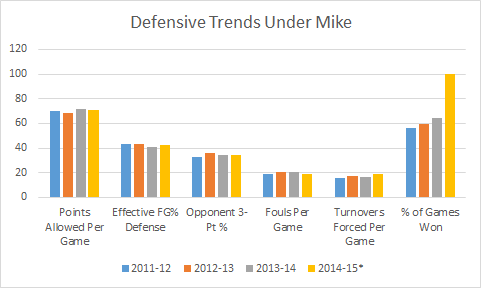 It’s likely older Razorback stars like Bobby Portis, Rashad Madden and Michael Qualls will play well at Iowa State, where the Cyclones are 50-4 the last five years, Iowan-Arkansan sportswriter Nate Olson points out. They proved they could deliver on the road last season and have played in similarly intense arenas like Kentucky’s.
It’s likely older Razorback stars like Bobby Portis, Rashad Madden and Michael Qualls will play well at Iowa State, where the Cyclones are 50-4 the last five years, Iowan-Arkansan sportswriter Nate Olson points out. They proved they could deliver on the road last season and have played in similarly intense arenas like Kentucky’s.
The pivotal issue is how Arkansas’ three first-year guards – Anton Beard, Jabril Durham and Nick Babb – play. “You’re as good as your guards take you,” Richardson said. So far, all three have played their supporting roles well but they have played in only one game away from Bud Walton Arena. While often what’s needed is a timely, clutch three in the vein of Scotty Thurman, this year the right play may simply be avoiding a turnover and making a timely entry pass to Portis. Last year, “we got discombobulated in the final few minutes of games,” Portis told USA Today, recalling seven losses in ten road games. “Are we going to finish teams off? That’s the biggest question.”
To me, North Little Rock native Anton Beard is the most important of the three young guards. Perhaps I’m simply biased, as I have followed him closely since he was a freshman in high school and seen many of his games at Parkview High and North Little Rock. He’s a champion, point blank, winning three state titles in four years. Point guards simply don’t start for Parkview coach Al Flanigan as freshmen. He’s the only one who has, and that season I watched him lead his team to a victory at Hall High School in the middle of its four-year run of consecutive state championships.
So far, Beard the collegian freshman has played the role of a scrappy, clutch shooter (46.2% on threes) off the bench who has a not-stellar 1.2 assists-to 1 turnover ratio. “Beard is moving in a pretty good direction,” Richardson said. “For the Razorbacks to be where they got to be, his game has got to improve.” Beard is fairly stocky, but Richardson says he (and all other current Razorback guards) don’t compare in the physical toughness department to Corey Beck, the point guard of his ’94 title team. “Beck was an animal.”
Perhaps the most apt comparison for Beard, at this point, is Arlyn Bowers who ended up pairing with Lee Mayberry as guards in Arkansas’ 1990 Final Four run. Two years before that, Bowers and Mayberry were just starting out as freshmen in Nolan Richardson’s fourth year as head coach.
Just six games into Year 4, it’s difficult to conduct a thorough comparison of Nolan Richardson and Mike Anderson as Razorback head coaches. Obviously, the jury’s still out on Anderson. But the sample size is large enough now to at least take a look:
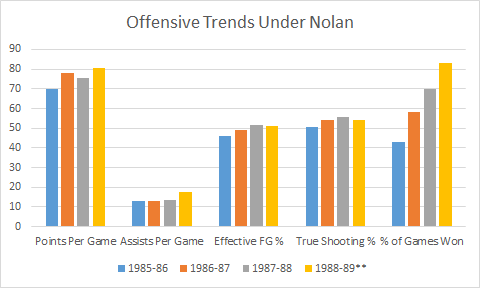 [Most conferences didn’t adopt the three-point shot until 1986-87. So 1985-86 Effective FG % stats reflect two-point field goal percentage only.]
[Most conferences didn’t adopt the three-point shot until 1986-87. So 1985-86 Effective FG % stats reflect two-point field goal percentage only.]
 Comparing these numbers with the last four seasons, we see Anderson’s teams have improved at more steady clip, year by year, in most categories. And from an overall statistical standpoint, Anderson’s Year 4 is significantly more impressive so far than Nolan’s.
Comparing these numbers with the last four seasons, we see Anderson’s teams have improved at more steady clip, year by year, in most categories. And from an overall statistical standpoint, Anderson’s Year 4 is significantly more impressive so far than Nolan’s.
But it’s important to note that Nolan’s Year 3 team finished 11-5 in conference vs. the 10-8 record Mike’s Year 3 team had. Nolan made the tournament in 1987-88 (losing in the first round to Villanova) whereas Mike hasn’t yet. In Year 4, Nolan got a massive injection of talent when Bowers and Mayberry arrived, along with fellow freshmen Todd Day and Oliver Miller. Their play paid immediate dividends, and the Hogs ultimately finished 13-3 in conference and 25-7 overall. They lost in the 1989 NCAA Tournament’s second round.
We’ll see if Mike’s Year 4 team keeps pace. A win tonight certainly certainly helps toward that end.
* November 29, 1997 was the last time Arkansas beat a ranked team on a neutral court in pre-conference play. Arkansas beat No. 17 Fresno State in Phoenix. And December 6, 1992 was the last time the program scored such a win on the road. The Hogs beat No. 9 Arizona in Tucson, AZ. Mike Bibby was 14 years old.
** Using data from six of Hogs’ first seven games in 1988-89 (Box score from Game No. 5 not available at HogStats.com).PS: Partial season data not available for Turnovers Forced Per Game, so this stat instead reflects per-game average from entire 1988-89 season.
Effective Field Goal % adds weight to three-point shots. Formula: (FGM + (0.5 x 3PM))/FGA
True Shooting % is similar, but also factors in free throws. Formula: Pts/(2*(FGA + (.44*FTA)))
Projecting Draft Potential of Bobby Portis – the UA’s 6th All-SEC Freshman
Posted: March 11, 2014 Filed under: Pro basketball, Razorback basketball | Tags: Bobby Portis, Dakari Johnson, Julius Randle Leave a commentArkansas freshman big man Bobby Portis earned a pair of SEC postseason honors on Tuesday, as the Little Rock native was named to the All-SEC second team and the SEC All-Freshman team..
According to the UA sports information department, the Hogs have landed 15 players on the SEC All-Freshman team while Portis is just the sixth freshman in program history to earn All-SEC honors. During his standout rookie campaign, Portis also collected three SEC Player of the Week accolades, which equaled the record previously set by current Houston Rocket Patrick Beverley in 2007.
One of Portis’ weekly honors came on the heels of breaking the Arkansas freshman scoring record with 35 points against Alabama on Feb. 5 at Bud Walton Arena, dethroning current Director of Student-Athlete Development Scotty Thurman. The 35-point night was the most by a Razorback since 2002, and the third-most points scored by an SEC player this season. Portis accounted for 29 of the team’s first 35 points, while also adding nine rebounds and a season-best six blocks.
Portis enters the SEC Tournament averaging 12.4 points and 6.6 rebounds, ranking second and first on the team, respectively. The 6-foot-10 forward has reached double figures in 20 games with a team-best three doubles and is the only Razorback to start all 31 games. Portis ranks 10th in the SEC in rebounding and tied for fifth in blocks (1.6), while also showcasing his all-round skill with 46 assists and 35 steals.
The first Arkansas signee since 2004, and the 13th overall, to play in the McDonald’s All-American game, Portis has lived up to the hype and has a chance to become the first freshman in program history to lead the team in scoring and rebounding in the same season. Portis also needs just 12 rebounds to break the freshman record of 211 set by Marshawn Powell in 2010.
Fifth-seeded Arkansas (21-10) will begin play at the SEC Tournament on Thursday, taking on the winner of Auburn/South Carolina in a 2:30 p.m. CT game on SEC TV. The Razorbacks earned a first round bye and head to Atlanta with wins in eight of their last 10 games.
So when and where will Portis end up going in the NBA Draft?
NBA Draft Express has him at #19 in the 2015 Draft, one behind Kentucky’s Dakari Johnson. Curiously, NBA Draftnet doesn’t have him listed at all. But at least one member of the drafterati – Dean Demakis – in February made a strong case for Portis one day being worth high first round consideration. Especially when compared to SEC Freshman of the Year Julius Randle, an apparently surefire Top 10 pick this year.
They are both skilled 5 star freshman PF’s who play in the SEC. Their tools are not far apart, as Portis has more length (7’1.5″ vs 6’11″ wingspan), Randle has more strength, and their athleticism and mobility appear to be similar (although perhaps Randle’s spryness would stand out if he trimmed down). Their offensive ratings adjusted for SOS and usage is close with Randle having a slim 1.8 point advantage. In a world that interprets draft related information with reasonable efficiency, a Portis vs. Randle debate would be raging right now….
Portis has superior defensive awareness and his length enables him to make more plays. I believe he clearly projects to be better on this end in spite of inferior rebounding. Offensively, Randle is a superior offensive rebounder and gets to the line far more, but Portis has a considerably lower turnover rate.
The Arkansas Activities Association Should Integrate Its Record Book
Posted: March 12, 2013 Filed under: Arkansas high school basketball | Tags: Bobby Portis, Eddie Miles, Evan James, Little Rock Hall, Scipio Jones High Leave a comment
Hall’s Evan James, center, is surrounded by teammates after making a last second basket to beat Jonesboro 32-31 in the 6A boys high school championship. It was the fourth straight title for LR Hall, a feat only accomplished by two other programs – Scipio Jones and LR Central. Courtesy: Arkansas Democrat-Gazette
In the scope of world history, high school sports isn’t all that significant.
You could study a 1,001 more subjects which have more of an effect on our everyday lives. My wife, who works as a pediatrician, deals with more life and death matters in the course of half of a minute than I will in a lifetime of work.
So there may only be a handful of people who care that a large part of Arkansas’ high school history is kept in the dark almost every time a major record is set.
Last year, I discussed this issue in the context of career scoring records set in basketball. The essential issue was that the Arkansas Activities Association only recognizes records that were set by the white student-athletes – but not black student-athletes – who played before integration.
Before the school integration that swept through the state in the late 1960s, there were two state athletic associations – one for whites, the other for blacks. Black students ultimately joined the white students in what had been the white students’ schools, leaving the black schools – typically in worse shape – behind. The same happened with the athletic associations. If the black athletic association kept its own records (it is unclear that such records were ever kept and if they still exist), then they have long been lost.
All that remain, officially, are the records that were kept in by what had been the all-white Arkansas Athletics Association.
This became most evident on Saturday, when Little Rock Hall High won its fourth consecutive state basketball title. This is a very rare Read the rest of this entry »
Exclusive Q&A w/ Bobby Portis, Arkansas’ Best Big Man Since Corliss
Posted: December 19, 2012 Filed under: Arkansas high school basketball, Razorback basketball | Tags: Bobby Portis, Corliss Williamson, LeRon Black, Little Rock Hall, Tyler Scaife Leave a comment
Bobby Portis learned the art of rebounding from Corliss Williamson. Courtesy: Arkansas Democrat-Gazette
Big man Bobby Portis is new school. He shoots threes, leads fast breaks and has a shoe collection as diverse as his game. Off the court, he rocks the same nerd-chic glasses and bow tie swag Kevin Durant has helped popularize in the NBA.
But when Portis takes his game to Fayetteville next season, it’s the promise of returning Arkansas to old school glory that most excites Hogs fans. Portis, after all, is the state’s best big man since his former coach Corliss Williamson. He’s already followed Williamson’s lead by leading the Arkansas Wings to an AAU national championship. The 6-10 senior center may also be the most dominant player from Little Rock Hall High since Sidney Moncrief, another Razorback All-American.
Portis, we find out, fully embraces the legacy of all his schools – past, present and future:
Q: Let’s get this out of the way first. You’ve been known to wear some crazy, neon-colored shoes on the court. How many do you have and why do you wear them?
A: I have Nike shoes in the neon pink, orange, blue, red and green.
It’s just a different style. I like to wear different types of colored shoes, you know. It’s nothing serious. My mom sees the shoes, so she buys them.
Q: Who is most responsible for helping you develop as a post player?
A: When I was little, it was Corliss Williamson. He taught me a lot. But then he moved on to coach UCA and couldn’t coach us [in AAU] anymore. Then I started working out with Marcus McCarroll. He’s in athletic trainer here in Little Rock, and he’s also a part of the Wings. He really helped improve my post game.
Bobby Portis Discusses How He Could Have Helped Arkansas Against Syracuse
Posted: December 5, 2012 Filed under: Razorback basketball | Tags: Bobby Portis, Little Rock Hall Leave a comment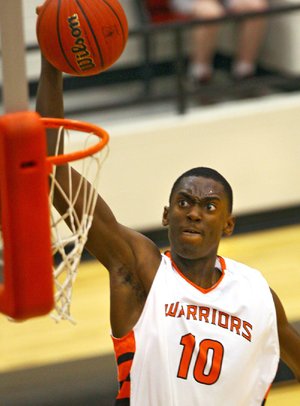 Courtesy Arkansas Democrat-Gazette
Courtesy Arkansas Democrat-Gazette
Last night I had a good interview with Razorback signee Bobby Portis, whom ESPN has ranked the nation’s 12th best senior. The 6-10 Portis plays for Little Rock Hall High, and a glance down his Twitter feed shows there are plenty Razorback fans who likely wish he’d skip his senior season altogether and join Arkansas for SEC play (a la Jarnell Stokes at Tennesse last season).
This won’t happen, but it’s fun to imagine.
Portis himself can’t help imagining how he could help this year’s batch of Hogs as he cheers them on. Last Friday night, he watched the Hogs fall 91-82 to No. 6 – ranked Syracuse and said he thought he could have used his size and quickness to neutralize the rangy, long athletes who comprise Syracuse’s famed zone defense:
Syracuse’s zone was just killing us. I think I could have flashed to the high post and knocked a couple jumpers down to make [the defenders] come up and then that would have opened up driving lanes for B.J. [Young] and Ky [Madden] to drive to the hole and stuff like that.”
It’s hard to argue Portis could contribute right away. Last summer, he took an unofficial visit to the Fayetteville campus and scrimmaged on a team including Kikko Haydar, Rickey Scott, Michael Qualls and Anthlon Bell. That team played against teams composed of other Hogs excluding Marshawn Powell, who was recovering from injury. Portis recalls his team going 5-0.
A more detailed Q&A with Portis will publish in the Dec. 19th issue of Sync magazine


